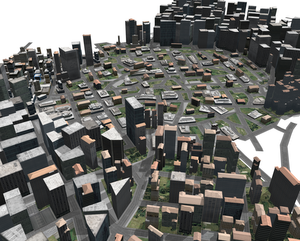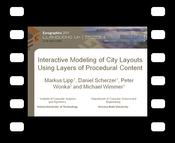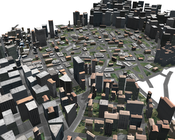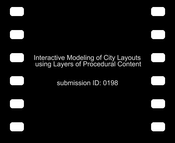Information
- Publication Type: Journal Paper with Conference Talk
- Workgroup(s)/Project(s):
- Date: April 2011
- Journal: Computer Graphics Forum (Proceedings EG 2011)
- Volume: 30
- Number: 2
- Location: Llandudno, UK
- Lecturer: Michael Wimmer
- ISSN: 0167-7055
- Event: Eurographics 2011
- Conference date: 11. April 2011 – 15. April 2011
- Pages: 345 – 354
Abstract
In this paper, we present new solutions for the interactive modeling of city layouts that combine the power of procedural modeling with the flexibility of manual modeling. Procedural modeling enables us to quickly generate large city layouts, while manual modeling allows us to hand-craft every aspect of a city. We introduce transformation and merging operators for both topology preserving and topology changing transformations based on graph cuts. In combination with a layering system, this allows intuitive manipulation of urban layouts using operations such as drag and drop, translation, rotation etc. In contrast to previous work, these operations always generate valid, i.e., intersection-free layouts. Furthermore, we introduce anchored assignments to make sure that modifications are persistent even if the whole urban layout is regenerated.Additional Files and Images
Weblinks
No further information available.BibTeX
@article{lipp2011a,
title = "Interactive Modeling of City Layouts using Layers of
Procedural Content",
author = "Markus Lipp and Daniel Scherzer and Peter Wonka and Michael
Wimmer",
year = "2011",
abstract = "In this paper, we present new solutions for the interactive
modeling of city layouts that combine the power of
procedural modeling with the flexibility of manual modeling.
Procedural modeling enables us to quickly generate large
city layouts, while manual modeling allows us to hand-craft
every aspect of a city. We introduce transformation and
merging operators for both topology preserving and topology
changing transformations based on graph cuts. In combination
with a layering system, this allows intuitive manipulation
of urban layouts using operations such as drag and drop,
translation, rotation etc. In contrast to previous work,
these operations always generate valid, i.e.,
intersection-free layouts. Furthermore, we introduce
anchored assignments to make sure that modifications are
persistent even if the whole urban layout is regenerated. ",
month = apr,
journal = "Computer Graphics Forum (Proceedings EG 2011)",
volume = "30",
number = "2",
issn = "0167-7055",
pages = "345--354",
URL = "https://www.cg.tuwien.ac.at/research/publications/2011/lipp2011a/",
}


 draft
draft




